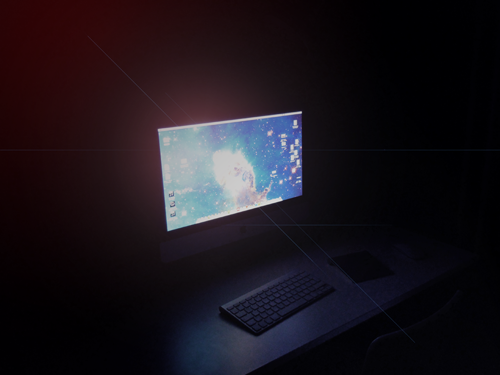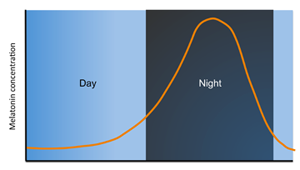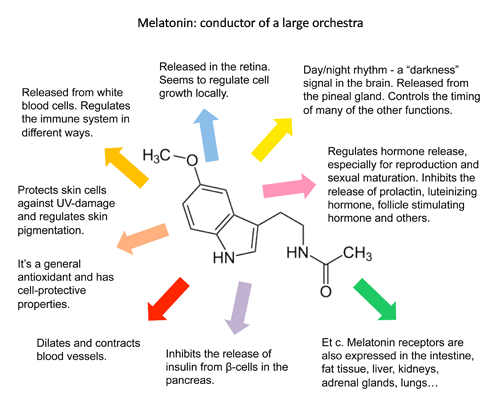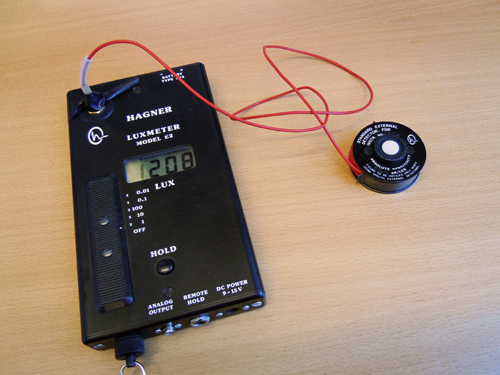
An all too common sight, at least at my place. This is my Mac glaring. But how is our exposure to low-intensity artificial light before bedtime affecting our sleep cycle?
One of the things I tell my students that usually raises some eyebrows is that even quite low-intensity light, comparable to the illuminance from a computer or television screen, as seen above, can affect the brain and shift the circadian rhythm significantly. This knowledge goes back to experiments carried out in the mid 90's and raises questions as to how artificial light, such an obvious and constant component of our environment, is affecting our day-night cycle.
In a recently published article in the Journal of Clinical Endocrinology (reference 1 below) a team of researchers has shown indirectly that it's the interplay between the SCN and melatonin secretion, so essential to the regulation of nighttime behaviors, that is affected by the artificial light in our environment.
 Melatonin
MelatoninMelatonin is essentially a "nighttime" signal in the brain. During the dark and inactive period of the 24 hour day-night cycle, melatonin secretion rises to a sharp peak only to start going down again in response to the first morning light. This is because in the absence of light input the SCN reduces its activity, signaling to the pineal gland in the brain to start secreting melatonin. This is only one of the many functions of melatonin. It's an incredibly pleiotropic hormone, meaning that you can find it throughout the body doing many different things. However, many of the functions seem to do with time keeping, or the control of processes that have a very strong connection to time-cycles and periods.

Melatonin's functions summarized (click to see larger). Adapted from Hardeland, R., Cardinali, D., Srinivasan, V., Spence, D., Brown, G., & Pandi-Perumal, S. (2011). Melatonin—A pleiotropic, orchestrating regulator molecule Progress in Neurobiology, 93 (3), 350-384 DOI: 10.1016/j.pneurobio.2010.12.004
The release of the hormones that regulate sexual maturation, for instance, is partly regulated by melatonin (see pink arrow in the image above). During our childhood we release a lot more melatonin overall than we do as adults. The onset of puberty is marked by a sharp decrease in overall melatonin, which seems to lead to the hormonal processes that start sexual maturation. It's as if the brain is "keeping time" and using melatonin as a signal to start and end hormonal and behavioral processes in just the right time and in just the right sync with our environment. This is what happens with our day-night cycle every day. Although melatonin isn't what makes you sleepy, that process happens somewhere else in the brain, it's one of the signals telling your body that it should be in "night-mode".
Artificial light affects melatonin release
It's already known that light exposure in the hours before normal sleep onset, even quite dim light, affects your day-night cycle, shifting it back - essentially making your brain believe that it's earlier than it really is. In early experiments it was shown that exposure to a light source as low as 180 lux can shift the circadian day-night cycle by about an hour (see reference 2 below), and from more recent experiments it's known that room light can delay the start of the nightly melatonin release. But how does the "internal clock", artificial light exposure and melatonin release interplay?
In an article from the March edition of Journal of Clinical Endocrinology (reference 1 below) a team of researchers describe a series of experiments showing that exposure to normal room light illuminance (<200 lux) before bedtime not only reduces the overall release of melatonin during sleep, but also shortens the period during which melatonin is released.
These figures illustrate some of their main findings. The A panels illustrate the experimental setup and the B panels the results:

To the left we see that when the test subjects were changed from room light conditions (<200 lux) in the 8 hours before bedtime, to dim light conditions (<3 lux) before bedtime (day 3) and all through their sleep (day 4) their melatonin profile changed! You can see the melatonin profiles of one participant in the left B panel. The arrows indicate the start of melatonin release. Under the dim light conditions the melatonin release started earlier in 99% of the participants with almost 80% showing an earlier onset of over an hour! So when exposed to room light before bedtime, the duration of melatonin release is shorter! There is also some indication that less melatonin is released during the night.
To see if melatonin release really was suppressed by the room light conditions, the experiment shown to the right was carried out. Instead of changing the test subjects from room light to dim light conditions before bedtime, they changed them to constant room light during sleep. You can see the results for five representative test subjects in the right B panel: Melatonin release was suppressed by up to approx. 90% in several of them!
These are some really sophisticated and neatly designed experiments with a large number of test subjects, but they suffer a little bit from a lack of connection to real life and relatable experiences. How intense do we perceive a light illuminance of 200 lux to be? How intense/illuminant are the lights we generally have at home or at work? How intense/illuminant is a computer screen or a TV screen? I looked around the web, and there's surprisingly little information out there. In most different studies of light exposure and circadian rhythm it's agreed that "normal" indoor room light starts somewhere below 200 lux and ranges up to about 500 lux, with "recommended office lighting" starting at around 350 lux. I decided to do a little bit of research myself, so I reached for the closest luxmeter and put it right here on my desk on a clear and sunny late spring day around 11 o'clock.

Luxmeter showing the light illuminance on my desk.
As you can see in the image, the light illuminance on my desk was around 1200 lux, far above the 500 lux that are cited as the upper limit of normal room lighting. Then again, my desk is right next to a very large window, so there is significant contribution from the sunlight outside. I've also measured the illuminance in the room when I'm lecturing about melatonin and circadian rhythms, to give the students a point of reference, and it has ranged from around 200 to 600 lux in generally pretty dim lecture halls with little contribution from outside daylight. I've also measured the illuminance from my MacBook screen and it usually ranges from 140 lux to 160 lux, more or less. These illuminances are all above or in the range of the illuminances discussed in the experiments.
These aren't exact or complete measurements, but I hope they at least give some kind of reference for the measures of illuminance given in the different experiments I've mentioned. I also hope that this post raises questions in you about your habits before bedtime. I freely admit that I love falling asleep to a DVD or reading long into the night, but quite a few of the students I lecture to are reluctant to accept that their cries of "I'm not a morning person" can be somehow related to what they did before going to bed. There are also questions concerning seasons left to consider. Here in the southern half of Sweden the sun is setting at about 10 o'clock at night right now. How does this affect our day-night cycle?
In any case, what we are seeing here is nothing less than the interplay between our brains - our behaviors and our physiology - and our environment. An interplay that in this case is mediated by the hormone melatonin. It may be the "nighttime signal" in your brain, but you can surely disturb it by changing the environmental cues that the brain has adapted to react to. What the consequences are, we don't quite know yet.
(1) Gooley, J., Chamberlain, K., Smith, K., Khalsa, S., Rajaratnam, S., Van Reen, E., Zeitzer, J., Czeisler, C., & Lockley, S. (2011). Exposure to Room Light before Bedtime Suppresses Melatonin Onset and Shortens Melatonin Duration in Humans Journal of Clinical Endocrinology & Metabolism, 96 (3) DOI: 10.1210/jc.2010-2098
(2) Boivin, D., Duffy, J., Kronauer, R., & Czeisler, C. (1996). Dose-response relationships for resetting of human circadian clock by light Nature, 379 (6565), 540-542 DOI: 10.1038/379540a0
Nice post. It's so engrained into our culture to watch TV/movies/read before bed that it took me a while to think of activities I might do before bed that don't involve floodlights. So far, I have listening to music, drinking, talking with friends, dancing, and having sex. And yet I don't remember being more of a morning person back when I was undergrad ;)
ReplyDeleteFunny that you are in Norway, I had a really hard time adjusting to the light going to the Lofoten Islands in early August a few years back, although I guess someone who was born there might be adapted to it somewhat.